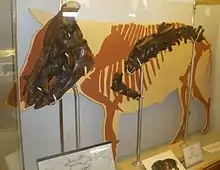Sus strozzi
Sus strozzi, or Strozzi's pig, was a suid native to the Mediterranean region of Europe. It was more primitive than the modern boar, and was eventually displaced by the latter when it entered Europe during the start of the Pleistocene, 1 Mya.[1]
| Sus strozzi | |
|---|---|
 | |
| Skull | |
| Scientific classification | |
| Kingdom: | Animalia |
| Phylum: | Chordata |
| Class: | Mammalia |
| Order: | Artiodactyla |
| Family: | Suidae |
| Genus: | Sus |
| Species: | †S. strozzi |
| Binomial name | |
| †Sus strozzi Forsyth Major, 1881 | |

Skeleton
Description
Strozzi's pig was larger than the modern day wild boar. A skeleton from a young specimen indicates an animal of 150 cm (4.9 ft), while incomplete remains from an adult indicate an animal with a head-and-body length of 183 cm (6.00 ft). One recently found fossil was a 35 cm (14 in) jawbone from a male, much larger than the jawbone of any modern day species of Sus.[2] It was possibly adapted to a swamp environment, and may have been ancestral to the modern Javan warty pig.[3]
References
- Biology and wildlife of the Mediterranean region, By Jacques Blondel, James Aronson
- http://www.perugiatoday.it/cronaca/ricerca-dell-universita-di-perugia-ecco-l-antenato-del-cinghiale-scoperto-in-umbria-un-bestione-da-record.html
- Kurtén, Björn (1968). Pleistocene mammals of Europe. Weidenfeld and Nicolson. pp. 153-155
External links
This article is issued from Wikipedia. The text is licensed under Creative Commons - Attribution - Sharealike. Additional terms may apply for the media files.